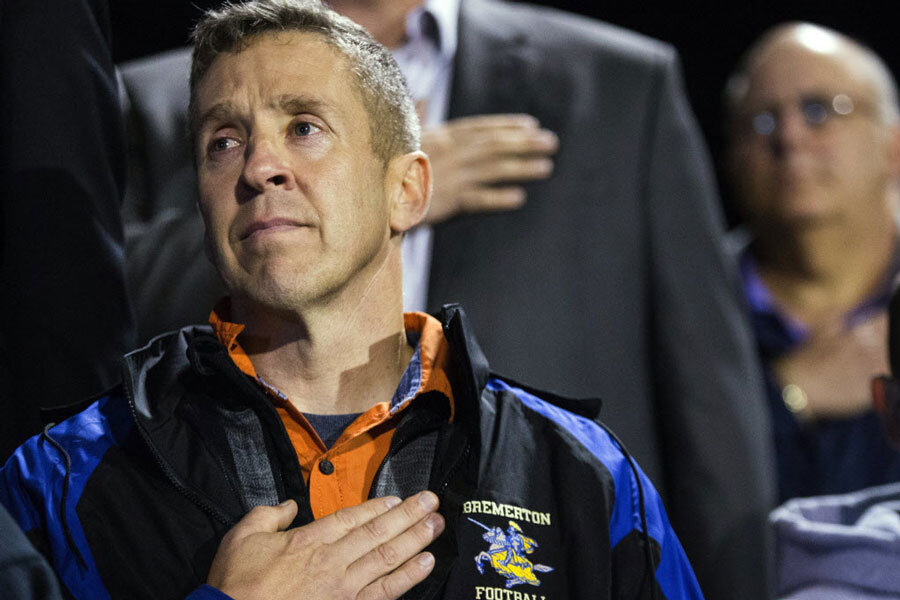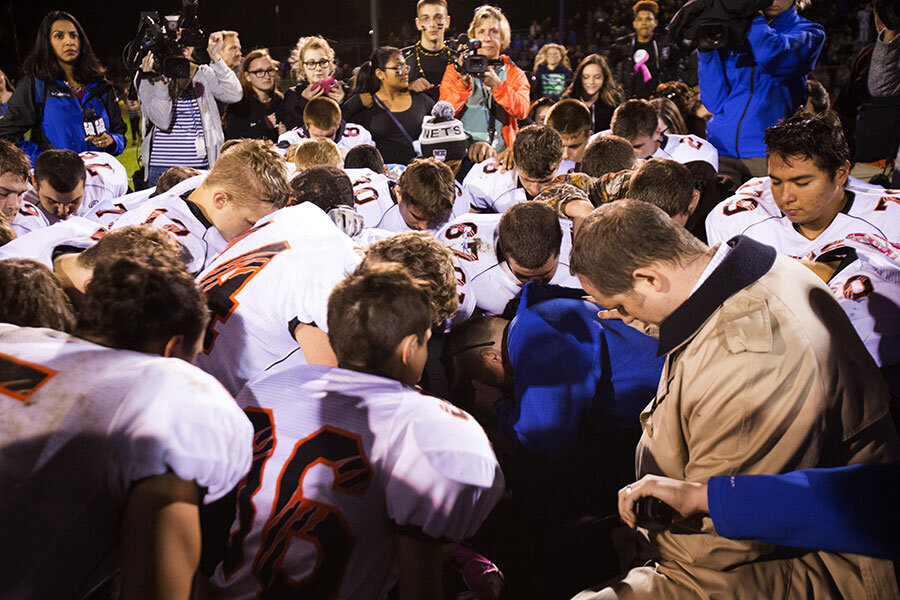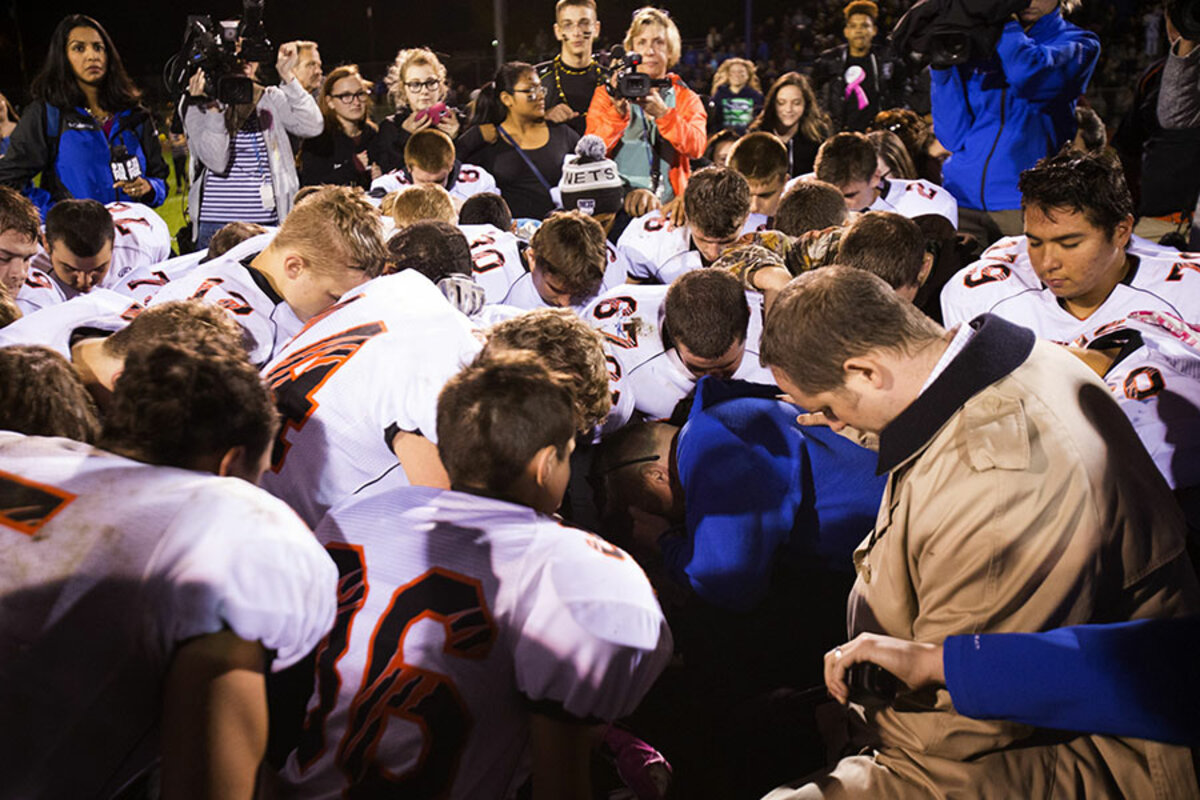Prayer at one Washington school: Religious freedom on the 50-yard line?
Loading...
At the 50-yard line of the high school football field, a battle is brewing over the meaning of the First Amendment.
The Bremerton School District in Washington State put assistant varsity football coach Joe Kennedy on paid administrative leave this week after he failed to comply with directives to stop overt public displays of religion on the field while on duty.
The showdown raises a key question: When does a public school district’s responsibility to follow the First Amendment’s establishment clause – barring the government from endorsing or showing preference for religions – trump a staff member’s rights under the free exercise clause, meant to prohibit government interference with religious practice.
In the context of the long-running “culture wars” in the United States, it’s hard for schools and other institutions to strike a balance. Many Christians feel as if their ability to express their religion publicly is getting squeezed, while religious minorities and nonreligious Americans protest the coercive potential of such public displays.
“The Supreme Court's pronouncements and precedents regarding prayer in public areas, prayer by public employees, and prayer in public schools are, to put it mildly, unclear,” says Rick Garnett, a professor at Notre Dame Law School in South Bend, Ind., in an e-mail to the Monitor. “The rules are hazy and, as a result, it is hard for lawyers and school officials to predict with certainty what courts will do in any particular case.”
The legal arguments
Some legal scholars say that various court rulings lean toward the district’s position.
“During the contract day, the First Amendment limits [the coach’s] expression of his faith with students” in order to maintain the school district’s neutrality toward religion, says Charles Haynes, director of the Newseum Institute’s Religious Freedom Center in Washington.
But there are gray areas, and “where exactly to draw the line is a tough question,” says David Hudson, a professor at Vanderbilt Law School in Nashville, in an e-mail to the Monitor.
For years, Coach Kennedy had led prayers before games in the locker room and after games at the 50-yard line, but only recently did it come to the attention of a district administrator, a statement from the school district notes. When officials asked him to stop overtly involving students, he complied, but he continued to pray himself after the game, on the field.
Kennedy had recently requested a religious accommodation, which employers are required to offer, when reasonable, under Title VII of the Civil Rights Act.
“I am devastated that the school district is denying me an opportunity to privately and silently pray for my players at the 50,” Kennedy said in a statement released by the Liberty Institute, a legal organization in Plano, Texas, that advocates for religious freedom. It plans to support legal actions on behalf of Kennedy.
The school district says it has repeatedly offered Kennedy the option of using a private location for prayer at athletic facilities or the stadium.
The Liberty Institute, in a statement, says the school’s actions amount to an “unconstitutional ban on visible religious expression.”
Haynes of the Newseum disagrees. “The demand to do it in front of everybody … reveals a kind of an agenda,” he says. “Students can pray … but the coaches need to stay out of the prayer business during their time as coaches.”
A similar dispute arose several years ago in East Brunswick, N.J. Football coach Marcus Borden challenged the district’s policy against faculty involvement in student-initiated prayer. He wanted to remain silent but take a knee during locker-room prayers.
A lower court ruled in his favor, but the Third Circuit Court of Appeals overturned that ruling in 2008. The opinion read in part: “we hold that Borden’s silent acts violate the Establishment Clause because, when viewing the acts in light of Borden’s twenty-three years … during which he organized, participated in, and even led prayer activities with his team, a reasonable observer would conclude that Borden was endorsing religion when he engaged in these acts.”
There is a gray area around when a staff member should be considered on duty, and therefore representing the public school. When students gather around a flagpole before school starts, for instance, should a teacher be able to join them? “There’s no bright line on that issue,” Haynes says.
The Bremerton case includes complicated questions, notes Professor Garnett of Notre Dame, such as: If the district were to allow Kennedy to continue his practice, would it also have to offer equal time on the field for other groups, including the Satanic Temple of Seattle? Several members of that agnostic and atheist group showed up to the football game Thursday night after being invited by some students and staff to show support for free expression, the Seattle Times reports.
Kennedy was in the stands rather than on the field that night, and prayed there after the game.
Students' right to pray
Because of the confusion over the tensions in the First Amendment, officials sometimes mistakenly give people the impression that no religious expression is allowed in schools at all, Haynes notes.
“Kids can pray in schools if they want to,” he says. “If public schools were better about recognizing the religious liberty rights of students … then I think there would be less pressure and less fighting about teachers and administrators.”
The extreme views on both sides of the culture wars don’t help, says Douglas Laycock, a professor at the University of Virginia School of Law in Charlottesville. “There are plenty of people who would like to suppress all religious speech … and confine it to churches. And there are plenty of people who think we should have prayer at every government meeting,” he says. “We would do a lot better if both sides would agree to protect their own liberties and also respect the liberties of the other side, but we’re not there.”








